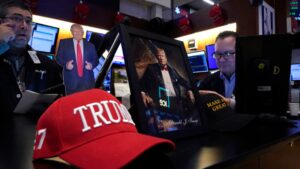Understanding the Rising Stagflation Fears in Today’s Economy
Recent reports reflect a growing concern around the specter of stagflation in the U.S. economy—a blend of stagnant economic growth and rising inflation reminiscent of historical challenges faced in the 1970s. The scenario, which has not been encountered in over half a century, is causing ripple effects across various sectors, prompting increased scrutiny from consumers, business leaders, and policymakers alike.
What Is Stagflation and Why Should You Care?
Stagflation refers to the uncomfortable coexistence of high inflation and stagnant economic growth. As inflation rates creep up, consumers are feeling the pinch, and there’s apprehension that it could derail the economic stability we’ve been trying to achieve post-pandemic. This potential economic illness poses unique challenges that could affect investment strategies and personal financial planning.
As articulated by Mark Zandi, Chief Economist at Moody’s Analytics, the current economic trajectory hints towards stagflation, largely influenced by policy decisions such as tariffs and immigration reforms. These elements combine to create a toxic mix of price hikes alongside slowing economic activity, leading to increased consumer uncertainty.
Trader Anxiety on Wall Street
The impact of these developments is clear on Wall Street, with traders adjusting their portfolios to adapt to the shifting landscape. Recently, the Dow Jones Industrial Average took a notable dip, reversing gains acquired post-election. Investors are increasingly fleeing towards safer assets like bonds, with demand rising as stock values slide, indicating a cautious market sentiment.
Despite these fluctuations, experts advise against panicking. Mark Hackett, Chief Market Strategist at Nationwide, emphasizes that this market correction might be a healthy resetting of expectations rather than an immediate precursor to a financial meltdown.
The Federal Reserve’s Balancing Act
One significant institution closely watching these economic indicators is the Federal Reserve. Market projections suggest a growing likelihood that the Fed will cut interest rates this year, with implications that could affect borrowing costs nationwide. However, there’s also a fear that the Fed may adopt a more aggressive posture to combat inflation, echoing the strategies of former Fed Chair Paul Volcker during a previous economic crisis.
"Historic stagflation may not be on the horizon due to the Fed’s proactive measures," says Zandi. However, if the economic conditions worsen, it’s a real possibility that more severe countermeasures could come into play.
Insights into Consumer Behavior and Expectations
Consumer sentiment is a vital barometer of economic health, and current conditions are not promising. The latest reports show long-run inflation expectations are hitting levels not seen in nearly three decades. Alarmingly, consumer spending experienced its largest decline in nearly four years, despite a rise in income. These trends signal an unusual dissonance in consumer behavior that could have lasting effects on the economy.
Moreover, the Institute for Supply Management’s recent survey highlights that factory activities are barely expanding, with new orders seeing a significant drop. The mounting pressures on consumers and businesses alike create caution, demonstrating how quickly sentiment can shift.
The Role of Tariffs and Long-Term Economic Strategy
White House officials assert that the immediate economic pain from tariff implementations will eventually yield long-term benefits that create a more robust manufacturing landscape in the U.S.—a break from the prevailing service-oriented economy. Such claims, while optimistic, require scrutiny and critical evaluation from investors and consumers alike.
Commerce Secretary Howard Lutnick mentioned a possible shift in market-based inflation expectations, suggesting a brighter economic future ahead. Yet, skepticism remains as to whether these promises will materialize when faced with ongoing uncertainty in inflation and growth.
What Lies Ahead?
Clarity on where the economy is headed could come from the forthcoming nonfarm payrolls report. If job growth remains strong, it might mitigate some panic surrounding stagflation fears. On the flip side, subdued labor market performance coupled with sustained wage growth could exacerbate the situation, validating stagnant growth narratives.
At Extreme Investor Network, we are committed to delivering the most accurate and relevant insights in economic trends and investment strategies. As discussions around stagflation escalate, our focus remains firmly on providing you with tools and analysis to navigate an uncertain economic landscape effectively.
In these times of heightened scrutiny, knowledge is power. Stay informed and invest wisely—your financial future depends on it.

